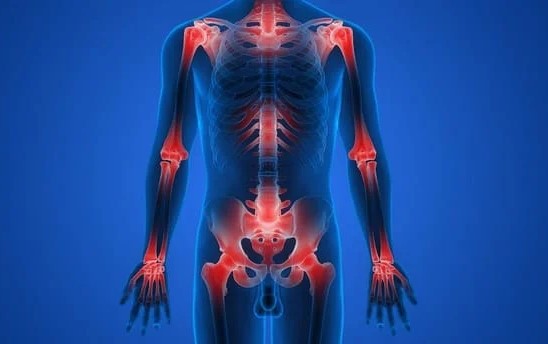
Chiropractic - Joint Pain
Joint Pain Overview
It's very important to consult with a healthcare professional to determine the underlying cause of joint pain and develop an appropriate treatment plan. Treatment may involve medication, physical therapy, lifestyle modifications, or other interventions to relieve joint pain and improve function.
Causes
Osteoarthritis: The most common form of arthritis. Osteoarthritis occurs when the protective cartilage that cushions the ends of bones in the joints gradually wears down, leading to pain, stiffness, decreased mobility.
Rheumatoid Arthritis: An autoimmune disease where the immune system mistakenly attacks the synovium (the lining of the membranes that surround the joints). This, undeniably, causes inflammation, pain, swelling, and joint damage.
Gout: A type of arthritis caused by the build-up of uric acid crystals in the joints. This leads to sudden and severe pain, swelling, and redness, often affecting the big toe.
Joint Injury: Trauma, such as sprains, strains, fractures, or dislocations, can damage the structures, resulting in pain, swelling, and limited movement.
Infectious Arthritis: Bacterial, viral, or fungal infections can invade the joint, causing inflammation, pain, and swelling.
Bursitis: Inflammation of the fluid-filled sacs (bursae) that cushion and lubricate joints, resulting in pain, tenderness, and swelling. Markedly, this is often aggravated by movement.
Tendinitis: Inflammation or irritation of tendons (the thick cords that attach muscles to bones) due to overuse, injury, or repetitive motion. Ultimately, this leads to pain, stiffness, and difficulty moving the affected joint.
Lupus: An autoimmune disease that can affect multiple organs, including the joints, causing pain, swelling, stiffness, and damage to joint tissue.
Fibromyalgia: A chronic condition characterized by widespread musculoskeletal pain, fatigue, sleeps disturbances, and tender points, often accompanied by pain and stiffness.
Other Causes: Factors such as aging, hormonal changes, metabolic disorders, certain medications, and lifestyle factors like obesity, sedentary behaviour, or poor posture.
Treatment
Chiropractors offer various treatments focusing on improving joint function, reducing pain, and enhancing overall musculoskeletal health. Here are some common chiropractic treatments:
Spinal Manipulation (Adjustments): Chiropractors use manual manipulation techniques to realign the spine and other joints in the body. This can help improve joint mobility, reduce inflammation, and alleviate pain associated with joint dysfunction.
Joint Mobilization: Gentle stretching and manipulation techniques are used to improve the range of motion and flexibility of affected joints. This can help reduce stiffness and discomfort, especially in joints that have become tight or restricted due to injury or inflammation.
Soft Tissue Therapy: Chiropractors may use soft tissue techniques such as massage, myofascial release, or trigger point therapy to address muscle tension, knots, and adhesions around the affected joint. This can help reduce pain and improve function by relieving tension and promoting blood flow to the area.
Exercise Therapy: Chiropractors prescribe specific exercises and stretches to strengthen the muscles surrounding the affected joint, stabilize the joint, and improve overall joint function. These exercises can help reduce pain, prevent further injury, and improve mobility.
Lifestyle Modifications: Chiropractors provide guidance on lifestyle changes, ergonomic adjustments, and posture correction to reduce stress on the joints and promote optimal musculoskeletal health. This may include recommendations for proper body mechanics during daily activities, ergonomic workstation setup, and weight management.
Nutritional Counselling: Chiropractors may offer nutritional advice and recommend dietary supplements known for their anti-inflammatory properties to support joint health and reduce inflammation. A healthy diet rich in vitamins, minerals, and omega-3 fatty acids can help reduce joint pain and inflammation.
Modalities: Chiropractors may use additional therapeutic modalities such as heat therapy, cold therapy, ultrasound, or electrical stimulation to alleviate pain, reduce inflammation, and promote healing in the affected joint.
Conclusion
It's important to note that chiropractic treatment for joint pain is often part of a comprehensive approach that may include other healthcare interventions such as physical therapy, medication, or lifestyle modifications. The specific treatment plan will depend on the individual's condition, symptoms, and goals, and should be developed in collaboration with a chiropractor or healthcare provider.
Call Fairview Physiotherapy & Rehab Centre Today and schedule an appointment with Dr. Roy Priesnitz !
Our clinics are located:
5 Fairview Mall Drive, Unit 250, Toronto, ON, M2J 2Z1, PH: 416-493-6993
20 Wynford Drive, Unit B3, Toronto, ON, M3C 1J4, PH: 416-441-6117
HOURS:
Wed-Thu 3am-7pm
Sat 9am-1pm